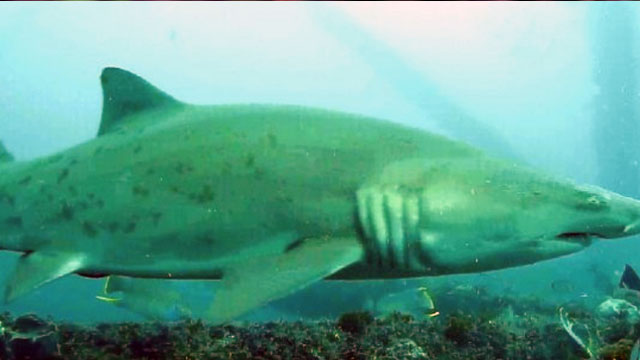If you’ve been watching our new underwater cameras at Frying Pan Tower, you’ve probably noticed that the change of the season has not only brought stormy weather but also some big, toothy fish to the neighborhood… Today, we meet the Sandtiger shark.
The Sandtiger shark (Charcharius taurus) inhabits coastal waters in the U.S. Atlantic Ocean from as far north as the Gulf of Maine and south to the northern Gulf of Mexico. They are identifiable by the two equal-sized dorsal fins on their backs. Take a look at the pictures below to see what we mean. If you have a good view of one (we recommend catching an up-close shot on our cameras instead of swimming this close!), you can also see spots on their upper bodies that are characteristic of this species.

Sandtiger spotted at Frying Pan Tower; Dec 5, 2014.
This time of year, female Sandtiger sharks migrate to the Frying Pan Shoal region and will be present for about 3-6 weeks, even up to 2 months, as these are important mating grounds for the Sandtiger. Most of the sharks that we will see on the underwater cameras here in the next several weeks will be females.

Can you see the equal-sized dorsal fins on its back? And the characteristic spotting on its side? (Image captured by viewer BeckyT-GA)
Don’t be alarmed at their appearance, this is one of the more docile shark species despite looking much more ferocious. One of the reasons that their population declined so rapidly do to fishing in the 1970s before regulations were put in place is because of their fierce features yet slow-moving, unassuming demeanor. The Sandtiger shark has been a protected species internationally since the late 1990s. For more information, click here.



